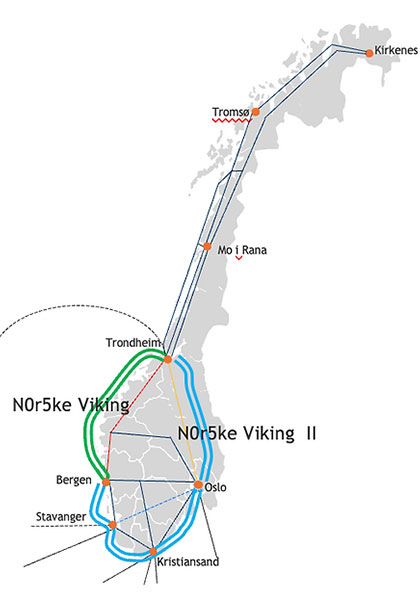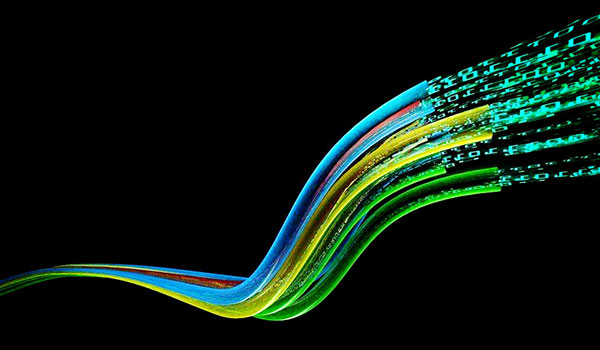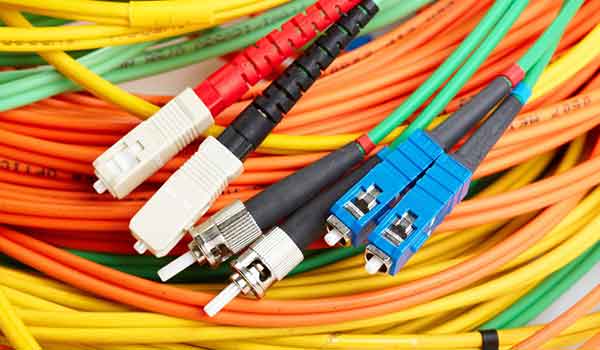Recently, N0r5ke Fiber AS revealed plans for the second phase of Norway’s digital infrastructure, which will see the construction of a 900 km submarine cable system connecting Bergen and Oslo.
There will also be a 500 km terrestrial fiber optic cable connecting Oslo and Trondheim.
When completed, it is reported that a 2,200-kilometer dark fiber ring will be formed.
Both new cables will contain at least 192 fibers connecting all international submarine fiber lines to and from Norway and large, established data centers in Norway.
Green data center expansion in a new region rich in green power production.
The expansion of N0r5ke Viking is said to significantly increase the redundancy and availability of dark fiber in Norway.
There are also redundant connections to major cities, connecting hubs, cable landing sites, and regions to provide easy access for international customers.
The existing 810 km N0r5ke Viking submarine cable will run along the western coast of Norway from Trondheim to Bergen, with 12 landing sites along the way.
So what exactly does a fiber optic cable look like? What are the features of how it can play such a big role? Here let the ZMS cable team take you to understand.

Fiber Optic Cable Definition
Fiber optic cable is a kind of communication cable.
It consists of two or more glass or plastic fiber optic cores.
These fiber optic cores are located within a protective overlay and are covered by a plastic PVC outer sleeve.
Signal transmission along the internal optical fibers generally uses infrared light.
In January 2013, Cuba made a change in communications by opening a fiber optic cable to add foreign channels drawing attention.
Fiber Optic Cable Development
China began research on fiber optic cable in the mid-1970s, almost simultaneously with foreign countries, and developed the first quartz fiber in early 1977.
Driven by the demand for large-scale communication construction in China, China’s fiber optic cable industry has developed rapidly and has formed a complete industrial chain from fiber optic pre-fabricated rods to fiber optic cable products.
The production and technical strength of China’s fiber optic cable companies have also grown rapidly, with product development capability and technological innovation capacity further improved.
China has become the world’s second-largest fiber optic cable country and has reached the world’s advanced level in all aspects.
What is more noteworthy is that the large-scale construction of 3G and the gradual start of FTTH will become the long-term driving factors for the great development of China’s fiber optic cable industry, which will certainly drive China’s fiber optic cable industry into a new round of growth cycle.
World Development
Cuba opened its first submarine fiber optic cable, making the speed of data unidirectional into Cuba has been improved.
Although there is still a long way to go to achieve the goal of “real freedom of access to the Internet”, this is indeed a real step forward on the road to change in Cuba.
Meanwhile, for the first time in nearly 50 years, Cuban TV also simulcast foreign broadcasters’ TV programs on the 20th.
Cuba is arguably the last country in the Western Hemisphere to be connected to fiber-optic cable and has one of the lowest rates of Internet connectivity in the world.
Previously, Cuba’s Internet service was mainly connected through a satellite system with very slow speeds.
About 16 percent of Cubans have access to the Internet, mostly because they use it in the course of their work and studies.
However, most of them are on the domestic LAN, which can be subject to many restrictions.
Only 2.9% of Cubans have unrestricted access to web pages from around the world within the country.

Fiber Optic Cable Medium Difference
Difference between fiber optic and cable
1. Material Difference
Cables are made of metal (mostly copper and aluminum) as the conductor.
Optical fiber uses glass fibers as the conductor.
2. Transmission Signal Difference
The cable transmits the electric signal. Optical fiber transmits optical signals.
3. Application Range Difference
Cable is now mostly used for energy transmission and low-end data information transmission (such as telephone).
Optical fiber is mostly used for data transmission.
Fiber Optic Cable Safety Performance
1. Historical and Practical Evidence
Aluminum cable has been developed and used for 43 years since 1968 in the United States.
The use of the product has been quite common, the market share of North American countries reached 80%.
After 43 years of practice proved that the use of aluminum alloy cable has never occurred failure, and is safe.
2. Testing and Certification
Aluminum alloy cable has passed the testing and certification of UL in the United States, CUL in Canada, and SAIGLOBAI in Australia.
Also includes China National Cable and Wire Testing Center, the State Grid Wuhan High Voltage Research Institute, the National Fireproof Building Materials Quality Supervision, and Inspection Center, and other authoritative institutions for testing and certification.
3. Aluminum Alloy Composition Role
3.1 Aluminum alloy conductor composition added to rare earth and iron and other components greatly improve its electrical conductivity and connection performance.
Especially when the conductor is annealed adding iron produces a high strength creep resistance.
In the case of current overload, iron plays a continuous connecting role so that the aluminum alloy conductor does not creep.
3.2 Creep is extremely harmful to the cable.
If the cable creeps, its contact points are not tight enough, and the pressure decreases so that the contact resistance increases rapidly.
The current flow causes overheating at the joints.
If not regularly serviced, there will be safety hazards.
It is very important to solve the cable creep problem.
What is Creep?
Metal under the action of temperature, external forces, and self-weight.
Over time, it will slowly produce a permanent deformation that cannot be recovered, this phenomenon is a creep.
4. Flame Retardant Performance
The insulation material of aluminum alloy cable adopts flame-retardant silane cross-linked polyethylene (XLPE), and the process adopts a self-locking armor structure, which is far better than the sheath of PVC material in heat dissipation, and the flame can be quickly dissipated, and the fire can be extinguished quickly after the flame disappears, so the flame retardant performance is extremely excellent. Aluminum alloy cable adopts new materials and new technology to ensure its safer use.

Fiber Optic Cable Electrical Performance
1. Cable Load Capacity
When the cross-sectional area of the alloy conductor is 1.5 times that of copper, the electrical properties of the alloy conductor and copper conductor are the same, achieving the same load capacity, resistance, and voltage loss.
The resistivity of aluminum alloy is between aluminum and copper, slightly higher than aluminum, and lower than copper.
The weight of an aluminum alloy conductor of the same length is only half that of copper at the same cross-sectional flow rate.
If the electrical conductivity of copper is 100%, the conductivity of the alloy conductor is about 61.2%.
The specific gravity of the alloy is 2.7 and the specific gravity of copper is 8.9, so (8.9/2.7) x (0.612/1) = 2.
That is, the resistance of 2 units of weight of copper is the same as the resistance of 1 unit mass of alloy.
Therefore, when the cross-sectional area of the alloy conductor is 1.5 times that of copper, its electrical properties are the same.
That is, the same cross-sectional flow, resistance, and voltage loss as copper is achieved.
Many factors affect the cross-sectional flow of power cables.
For example
1. Line Characteristics
Such as operating current, current type, frequency, and load factor.
2. Wire and Cable Structure
Such as the structure of the conductive core, the number of cores, the type of insulation material, the structure and material of the shield and the inner and outer sheath, and the total external diameter.
3. Laying Conditions
Such as air laying, pipeline laying, direct buried laying, underground trench laying, and underwater laying.
4. Operating Temperature Environmental Conditions
Such as air and soil temperature, soil thermal resistance coefficient, proximity effect of surrounding heat sources, etc.
2. Reduce the Outer Section of the Cable
Aluminum alloy cable production process, the most advanced tight compression technology in Germany, so that its conductor filling factor can reach 93%.
And aluminum alloy cables are made of silane cross-linked polyethylene, insulation that requires only 2/3 of the thickness of polyvinyl chloride to far exceed conventional insulation performance.
Whereas the filling factor of copper can only reach 80% in general, the commonly used insulation is PVC.
Therefore, the outer diameter of aluminum alloy cable is only increased by 11% or less based on copper cable, and it can have the same electrical performance as copper. It can be seen that the use of aluminum alloy cable does not need to change the original piping design of using copper cable.
Because the general designer designs the laying pipe size as 150% of copper cable.
Considering the problem of capacity increase, the size of the laying pipe is increased to 200% of copper cable, so it is not a problem to wear the pipe.
3. Reduce Cable Loss
Non-magnetic material, will not produce eddy current and can reduce the loss of the line.
Aluminum alloy with even armor locking material is a non-magnetic material.
Even if there is a three-phase unbalanced current, it will not produce eddy currents, which can reduce the loss of the line.
Fiber Optic Cable, Network Cable, Cable Difference
In the network hardware, there is another category that cannot be ignored is the network transmission medium, which we usually call network cable.
The more common network cable is divided into fine twisted pair, fiber optic cable, coaxial cable, thick coaxial cable, etc.
1. Fiber Optic Cable
Fiber optic cable is a new generation of transmission media.
Compared with copper media, fiber optics both in terms of security, reliability, and network performance have been greatly improved.
In addition, the bandwidth of fiber optic transmission greatly exceeds that of copper cable.
And its support of the maximum connection distance of more than two kilometers is the inevitable choice for the formation of large-scale networks.
Because fiber optic cable has the advantages of good anti-electromagnetic interference, strong confidentiality, fast speed, large transmission capacity, etc.
So it is also more expensive and rarely used in domestic settings.
There are two different types of fiber optics, single-mode fiber and multimode fiber, which are more common.
The term “mode” refers to a bundle of light that enters the fiber at a certain angle.
1.1 Multimode Fiber
Multimode fiber is generally used for network connections in the same office building or in relative proximity to each other.
1.2 Single-Mode Fiber
Single-mode fiber delivers higher quality data over longer distances.
It is often used to connect office buildings or to more widely geographically dispersed networks.
If fiber optic cable is used as the network transmission medium, additional equipment such as optical transceivers are required.
Therefore, the cost investment is greater and is less used in general applications.
2. Twisted Pair
A twisted pair cable is a flexible communication cable containing pairs of insulated copper wires.
It is widely used because it is characterized by its low price.
For example, we commonly see telephone lines.
Depending on the maximum transmission rate, twisted pair cables can be divided into three levels.
2.1 Category 3 twisted pair
2.2 Category 5 twisted pair
2.3 Super Category 5 Twisted Pair
Category 3 twisted-pair cable has a rate of 10mb/s, Category 5 up to 100mb/s.
Super Category 5 is up to 155mb/s or more.
This is suitable for the future needs of multimedia data transmission, so it is recommended to use category 5 or even super category 5 twisted-pair cable.
The twisted-pair cable can also be divided into shielded twisted pair (STP) and unshielded twisted pair (UTP).
Although the rate of stp twisted-pair cable is lower (only 4mb / s), the anti-interference than utp twisted-pair cable, so the price is also much more expensive.
This type of twisted-pair cable cheap a few dollars a meter, expensive well may be more than ten dollars to buy a meter.
In contrast, utp twisted-pair cable price is generally in a meter of a dollar or so, relatively inexpensive.
In addition, commonly used 10m and 100m unshielded twisted-pair cables are popularly known as 10base-t and 100base-t.
And twisted pair cable supports the use of rj45 crystal head used to make twisted pair cable and network card rj45 interface between the connector.
Its quality is directly related to the stability of the entire network, and can not be ignored.
3. Coaxial Cable
Coaxial cable is more familiar to many friends of a class of transmission media.
It is a layer of insulated wire wrapped around the central copper conductor of the cable line.
Its biggest feature is good anti-interference ability, stable transmission data, and also cheap.
So it was once widely used, such as closed-circuit television lines.
3.1 Advantages
The bus structure network composed of coaxial cable is less costly and used more in the past.
3.2 Disadvantages
The damage to a single cable may lead to the whole network being down, and maintenance is difficult.
Nowadays, coaxial cable is not used much, but there is still some market for fine coaxial cable.
The fine coaxial cable line is generally sold in the market for a few dollars a meter, which is not too expensive.
In addition, the coaxial cable is used to connect with the bnc head.
The coaxial cable sold in the market is generally connected to the bnc head and the finished product can be used directly.
The above is a detailed introduction to fiber optic cable. With extremely rapid global development, the use of cables is increasing. And a variety of cable resources that can be used sustainably are being developed. ZMS cable company has been concerned about cable development, and always adheres to providing high-quality cables, good value for money, thoughtful service, products after a strict manual qualification, trustworthy.